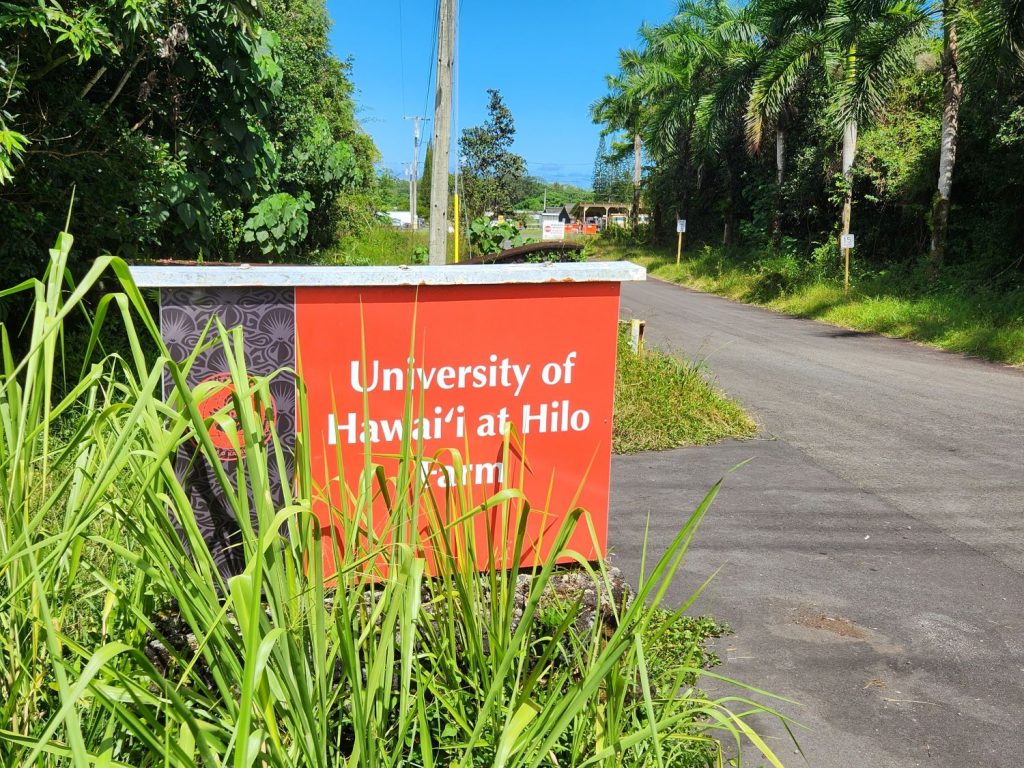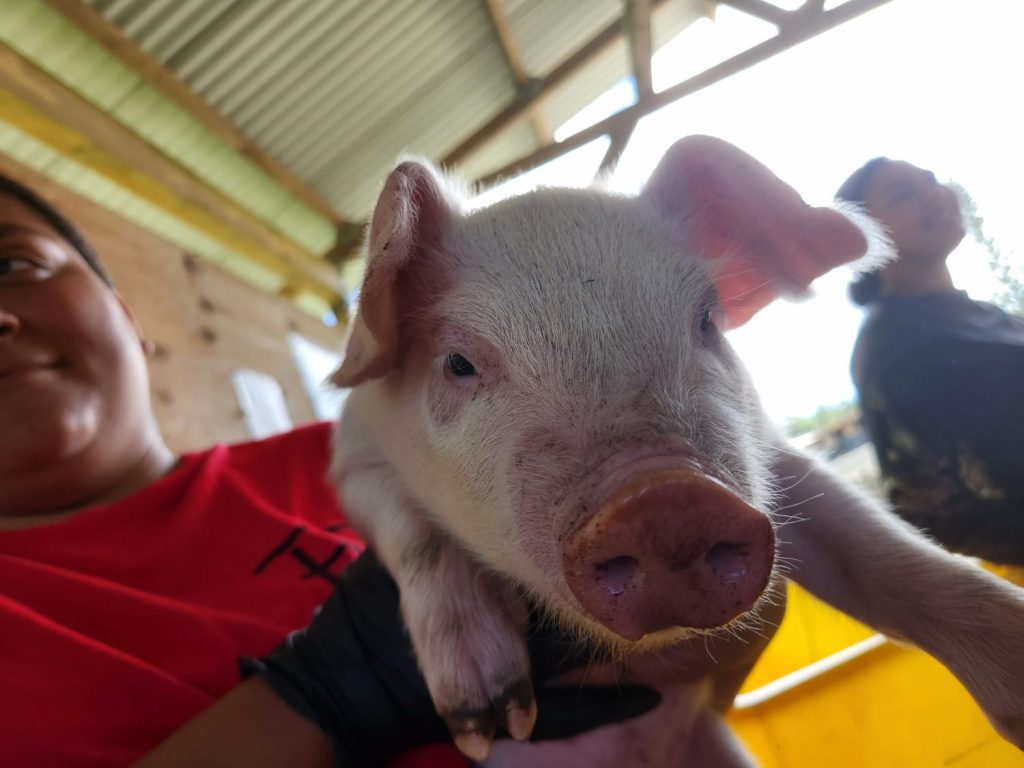A UH Hilo study may find out if invasive gorse can help lower feed costs
When Franny Brewer was a teacher, she would take high-schoolers to the slopes of Maunakea for service projects.
“We would stop at a gorse patch and I’d hold up a $20 bill and offer it to any student who could make it 10 feet in,” said Brewer, now the acting program manager for the Big Island Invasive Species Committee. “The boys, especially, would jump out, convinced they were gonna get that $20.”

However, once the students got up close and saw the density of the impenetrable, woody, yellow-flowered shrub — and all the spines covering it — “most turned around without even trying,” Brewer said.
Gorse, or Ulex europaeus, has made the top 100 list of worst invasive alien species in the world by the International Union for Conservation of Nature. It can grow to more than 10 feet tall and live up to 30 years. Gorse patches already have taken over thousands of acres of former pastureland on the Big Island and could take over more because it is extremely hardy and resistant to nearly all attempts to control, including herbicides.
But at the University of Hawai‘i at Hilo Farm in Pana‘ewa, between Hilo and Kea‘au, a new study is in the works that would take a stab at trying to cull the scourge that is gorse by investigating if it could make a viable feed for livestock.
The goal would be to determine how gorse would stack up against more traditional commercial feedstocks such as corn, soybeans and alfalfa, which livestock producers on the island pay an extra premium for because of shipping costs.
“The state, the nation, the world found out decades ago that it’s cheaper to ship the animals to the feed than the feed to the animals,” said Nick Krueger, instructor of integrated crop livestock systems at the UH-Hilo College of Agriculture, Forestry and Natural Resources.
As an example, a square bale of alfalfa that would cost from $8 to $12 on the mainland, maybe even as little as $5, costs $50 on the Big Island, he said.
While the study is only tentative, it recently received a boost in the form of a $500,000 grant approved in October by the Hawai’i County Council. The money will be used by nonprofit Hui Ho‘olako For Hawaiian Initiatives, a partner in the study, to harvest gorse from Maunakea, renovate the feed mill near UH-Hilo’s Pana‘ewa farm and conduct the study.
The plan for the study involves UH-Hilo swine production students under Krueger’s guidance growing two groups of weaned piglets to market weight, over a period of four months early next year. One group would be fed traditional commercial feedstock while the other would be given a feed made from pulverized gorse cleared from areas on Maunakea.
The study would analyze how the pigs grow in each group to find out if those fed the gorse grow as quickly and as large as those getting the traditional feedstock.
“So, if animals can essentially gain weight on this feed, then it’ll be a viable feed and [gorse] will be another material that can go into the feed supply component of the market and drive the price down, hopefully, for feed for livestock,” Krueger said.
He added that if a gorse feedstock was found viable and could even just start chipping away at the costs of feed, especially while at the same time helping to control an invasive species, it would be a win-win.
Smaller livestock producers on the island, who Krueger guarantees are feeling the pain of high feed prices, would get the most value from an additional feedstock that could be produced here.
Krueger knows there’s a ton of gorse readily available on Maunakea, and with a nearby high-capacity feed mill that has sat unused for years that would be used to make the gorse feedstock pellets for the study, the potential is there for mass production if it is found to be a viable option.
“Why not try it out? Let’s see,” he said.
Gorse is native to Italy, Corsica, Spain, Portugal, France, Switzerland, Germany, Great Britain, Ireland and The Netherlands. The spiny shrub was probably introduced to Hawai’i at about the turn of the 20th century and was considered an invasive weed by 1925.
According to a report from the Hawai‘i Gorse Task Force to the Hawai‘i Legislature in January 2021, gorse occupies at least 10,000 acres of former pastureland between 5,000 and 8,000 feet in elevation in Humu‘ula and Pi‘ihonua on Maunakea. Because the infestation is not effectively contained, there is the potential the plant could spread around the island and become established at elevations of 3,300-8,000 feet.
“Areas within this elevation range with suitable soils and conditions for gorse could include up to 500,000 acres on Hawai‘i Island alone,” the report said.
Brewer said people have been trying to solve the gorse problem for decades.
“There were several biocontrols released,” she said. “There have been other attempts to use gorse for commercial enterprises in the last decade that we were contacted about, as biochar or as a biofuel. I haven’t heard anything about that in a while, so perhaps they did not pan out.”
Gorse eliminates all other plants in its path.
“About the only way to get rid of it is to bulldoze, but the seed bank is incredibly long-lived so you will still get re-sprouting everywhere,” she said. “The plant is also fire-adapted — in fact, heat encourages the plant to shoot seeds several meters away.”
Brewer said the Big Island Invasive Species Committee is always supportive of efforts to use widespread invasive species to produce value, as long as production of those resources doesn’t spread the plant.
“There are literally thousands of acres of gorse on Maunakea and those lands are rendered nearly valueless either for production or ecosystem services — they cannot serve as forage for cattle, they offer no habitat for native birds and insects, they work against the health of our watersheds,” she said.
Krueger explained that by pulverizing the gorse into almost a powder to produce the feedstock through the study would remove the viability of any seeds. UH-Hilo and its partners in the study, including ranches that would be clearing and providing the gorse, would take great care not to accidentally spread the gorse.
“Hopefully we can get rid of some of that nasty gorse on the slopes of Maunakea and turn it into a viable livestock feed,” said Glenn Sako, an economic development specialist for agriculture with the Hawai‘i County Department of Research and Development.
He spoke during the Sept. 20 meeting of the Council’s Finance Committee during which the resolution for the grant was introduced.
Council members agreed that if the gorse feedstock was found to be a viable option, it could be a game changer.
Finance Committee Chairman Matt Kaneali‘i-Kleinfelder said: “I see this as a potential stepping stone for really moving toward sustainability of our feed and projects like this on Hawai‘i Island. I think gorse would just be the beginning.”
Krueger said hats off to the Council for providing the funding for a study that could provide a common-sense solution for tackling the problem of gorse and hopefully finding a more affordable feedstock option for the island’s producers.
He also likes that the study would provide exposure to his students to agricultural and livestock research right here on the Big Island that they wouldn’t otherwise have. It also would take them beyond square one in agriculture science of just raising animals. It becomes about what can be improved and the ability to identify objective differences in management.
“It takes it up a level from, OK, this is processing piglets, you notch ears, you clip teeth, great, great, and it morphs that into, OK, what’s the standard deviation of this experimental group relative to this one, right? Is there a significant difference?” Krueger said. “And it really exposes them to higher-tiered science that’s useful for doing good in our communities and furthering scientific knowledge.”












